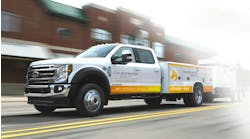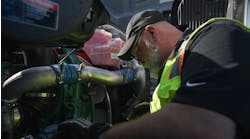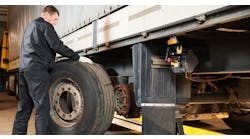There comes the time when it makes sense to modernize a maintenance facility and make improvements in safety, productivity and the environment. Shop equipment wears out, the equipment needs to change and new, improved equipment is constantly coming to market. Vehicle mix changes, and that results in adjustments to vehicle service and repair requirements. Not having enough space for all shop activities can severely impact productivity.
A shop update is the ideal time to consider all of the things that will increase both shop and technician productivity. This includes designing proper space allocation of tools, supplies, equipment, fluids, monitors and support services.
A maintenance facility requires order and discipline, says John Dolce, fleet specialist for Wendel, a nationally recognized architectural and engineering firm well known for its Transit Oriented Development initiatives, bus maintenance and multimodal facility designs. Almost every act needs to be sequenced for efficiency and to maximize productivity.
With good planning, a shop can also be “greened” by embracing environmentally-friendly architecture and reducing energy consumption and carbon dioxide emissions, he adds.
Because of funding limitations and priorities, organizations tend to make do with their mature facility by adapting staff and space to meet the immediate needs, but that can come at the cost of productivity and energy loss, Dolce says. With stimulus money now available for emissions reductions and a heightened focus on environmental stewardship, organizations should begin to look for opportunities to fund, build, expand or upgrade their facilities.
VITAL CONSIDERATIONS
The first step is to decide whether to expand a present shop, reduce its size, relocate to another facility or build a new shop. Architect and engineering firms are experienced to efficiently and cost-effectively assist with these efforts, says Dolce.
Among the chief considerations are space and technician requirements. Not having enough space or technicians can be just as bad as having too much space and too many technicians because these are capital expenses, he points out.
Energy use is another key consideration in greening a shop, says Dolce. One way to reduce energy consumption is to, as shop equipment wears out, replace it with newer, more energy-efficient units that use less energy. This will result in a savings on utilities and fuels and will reduce carbon dioxide emissions which benefits the environment.
By shop equipment, he means not just tools and machinery like lifts, cranes, washers, lathes, steamers, generator, welding equipment, parts cleaners and electronic test equipment. There is also facility management equipment and systems, such as heating, ventilating and air conditioning equipment, fans, ventilators, pumps, transformers and lighting.
ENERGY COSTS
An effective energy management plan begins with data collection and analysis, after which energy savings measures can be put in place, then monitored and controlled.
Dolce advises shops to perform an energy audit. Basically, an energy audit is an assessment of a company's energy use throughout its operations. The audit will identify opportunities for energy savings, energy efficiency improvements and possible alternative energy sources.
An energy audit shows a shop how to reduce carbon emissions by reducing its electrical draw, he says. This in turn will reduce utility generation, and that reduces fossil and gas usage. Changes can be as simple as replacing light bulbs with more efficient ones or as complex as replacing electrical needs with solar or wind technology by rehabbing present facilities with cost-saving technologies.
“It is a complex process but not overwhelming,” says Dolce.
ENERGY EFFICIENCY
Immediate energy savings can be achieved by simple practices. For example, moderating summer and winter thermostat settings can make a real difference. Heating, ventilating and air conditioning are usually a building’s biggest energy costs.
Energy conservation can also be accomplished by automating and controlling building equipment and systems, which promotes more active energy management.
Using good-quality, insulating windows and place windows to allow daylight to reduce lighting use, while providing solar warmth in cool weather. Studies have shown that natural lighting has a positive impact on productivity and well-being.
OTHER MEASURES
“Green roofs,” where a vegetative layer is grown on a rooftop, provide shade and remove heat from the air through evapotranspiration, reducing temperatures of the roof surface and the surrounding air. According to the U.S. EPA, on hot summer days, the surface temperature of a green roof can be cooler than the air temperature, whereas the surface of a conventional rooftop can be up to 90 degrees F warmer.
In-floor heating systems reduce utility costs and help improve employee comfort. Solar photovoltaic arrays on the roof can provide on-site renewable energy.
There are also a number of things than can be done for water efficiency. Dual plumbing can be designed to use recycled water for toilet flushing. Wastewater can be minimized by using ultra low-flush toilets, low-flow shower heads and other water-conserving fixtures.
For building construction, passive design strategies can dramatically affect building energy performance. These measures include the building shape and orientation, passive solar design and the use of natural lighting. Using sustainable construction promotes resource conservation and energy efficiency.
ASSORTED BENEFITS
U.S. Green Building Council (USGBC) has developed the LEED (Leadership in Energy and Environmental Design) green building certification program. It provides third-party verification that a building was designed and built using strategies aimed at improving performance across all the metrics that matter most. These are energy savings, water efficiency, CO2 emissions reduction, improved indoor environmental quality and stewardship of resources and sensitivity to their impacts.
The USGBC is a non-profit organization dedicated to sustainable building design and construction.
While a green maintenance facility may cost more up front, a number of economic benefits come from shop greening. Among them: lower operating costs, improved productivity and optimized life cycle economic performance.
Other paybacks of green buildings are not easily quantified. Things such as improving occupant health and comfort, and reducing pollution and landfill waste are less tangible green building benefits.
VARIOUS PATHS
The greening of vehicle maintenance facilities can be approached from three angles: maintaining green shops, maintaining green fleets and maintaining alternative fuel/advanced technology equipment, says Suzanne Seivright, manager of regulatory affairs and compliance at Valley Power Systems, a member of the WheelTime Network. “All three offer benefits in future opportunity and new revenue streams, while also requiring investment of resources and time.”
WheelTime is a professional truck care and service network that offers service support through more than 30 training facilities and nearly 200 service centers located across the U.S. and Canada.
She offers the following considerations for those shops getting ready to go “green.”
- Maintaining green shops - Green fleets will want to align with green shops and knowledgeable resources, says Seivright, who has extensive experience in the environmental field, working in both the public and private sectors.
“Technicians with experience in hybrid-electric, natural gas and advanced diesel engine and emissions systems may be hard to come by at these early stages of technology adoption,” she says. “Training and retaining factory-trained technicians that specialize in alternative fuel and advanced technology equipment will be key. Once you have them trained, you may find demand for onsite training of customer shop personnel adds extra value to your relationship and extra revenue for your shop.”
Technologies are coming on strong, she notes. In some cases, these are being mandated for use in certain states like California, and those policies are expected to spread to other states in the near future.
- Maintaining green fleets - Longevity and functionality of emissions control technologies post installation is directly related to proper engine maintenance, says Seivright. Operations and maintenance personnel need to be trained so they are prepared for their role in maintaining after-treatment systems. “U.S. EPA SmartWay Approved idle reduction technologies will be a mainstay of green fleets going forward,” she says.
- Working with alternative fuel fleets - In addition to tracking performance and benefits of extended life treatments and green additives such as oil, ethanol and biodiesel, green shops will be called upon to help fleets navigate federal, state and local funding opportunities that promote the purchase of alternative fuel vehicles, Seivright says.
“Gearing up for this demand takes a new expertise in grant writing, as well as knowledge on compliance procedures and air district regulations related to new vehicle purchases, retrofits and repowers. While facilitating workshops and local air quality board collaborations takes time, resources and investment, we (Valley Power Systems) find the commitment aligns our business with the needs of fleet customers that are going green.”




